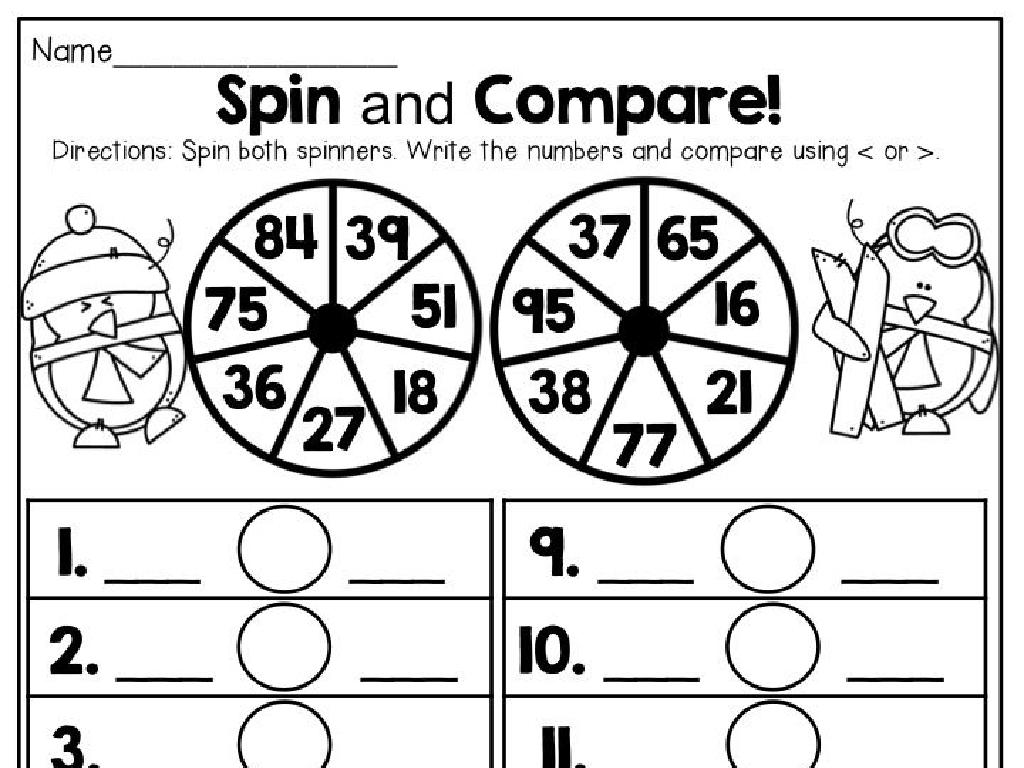Multiply And Divide By A Power Of Ten: With Exponents
Subject: Math
Grade: Fifth grade
Topic: Divide Decimals By Powers Of Ten
Please LOG IN to download the presentation. Access is available to registered users only.
View More Content
Multiplying by Powers of Ten
– What are powers of ten?
– Powers of ten have a base of 10 and an exponent showing how many times to use 10 in a multiplication.
– Multiplying by 10, 100, 1000
– Multiplying by 10, 100, or 1000 moves the decimal point to the right by 1, 2, or 3 places respectively.
– Visualize shifting place values
– Imagine the digits in a number moving to the left to show multiplication by 10, 100, or 1000.
– Practice with examples
– Example: 3.5 x 10 = 35; 3.5 x 100 = 350; 3.5 x 1000 = 3500
|
This slide introduces the concept of multiplying decimals by powers of ten. Begin by explaining that a power of ten is simply the number 10 raised to an exponent, which tells us how many times to multiply 10 by itself. Emphasize that when we multiply a number by a power of ten, we’re essentially shifting the decimal point to the right, making the number larger. Use visual aids to show how the place values change when multiplying by 10, 100, and 1000. Provide several examples for the students to work through, ensuring they understand the concept of place value movement. Encourage students to practice with additional problems to solidify their understanding.
Exponents and Powers of Ten
– Understanding exponents
– An exponent tells us how many times to multiply a number by itself.
– Writing powers of ten
– For 10^3, write ’10’ and use ‘3’ as the exponent to show 10 x 10 x 10.
– Reading exponents aloud
– Say ’10 to the third power’ or ’10 cubed’ for 10^3.
– Practice with exponents
|
This slide introduces the concept of exponents as it relates to powers of ten, a fundamental part of understanding place value and performing operations with decimals. Start by explaining that an exponent is a small number written above and to the right of a base number, indicating repeated multiplication. Show how powers of ten can be written succinctly using exponents. Practice reading exponents correctly, emphasizing the terminology like ‘squared’ for 2 and ‘cubed’ for 3. Engage the class with examples, such as 10^2 (10 squared) equals 100, and ask them to write and read exponents. Provide exercises where students write powers of ten as both repeated multiplication and with exponents, and vice versa.
Multiplying by Powers of Ten
– Understanding the zero pattern
– Each power of ten adds a zero to the number
– Multiply 3 by 10, 100, 1000
– 3 x 10 = 30, 3 x 100 = 300, 3 x 1000 = 3000
– Class practice with different numbers
– Students will multiply given numbers by 10, 100, 1000
– Recognize the power of exponents
|
This slide introduces the concept of multiplying by powers of ten and the resulting pattern of zeros. Start by explaining that for every power of ten we multiply, we add a zero to the original number. Provide the example of multiplying 3 by 10, 100, and 1000 to illustrate this pattern. For class practice, give students a variety of numbers to multiply by powers of ten to reinforce the concept. Emphasize the role of exponents in representing powers of ten and how they simplify multiplication. The activity should include multiplying single, double, and triple-digit numbers by 10, 100, and 1000 to cater to different skill levels.
Dividing Decimals by Powers of Ten
– Effects of dividing by powers of ten
– Dividing by 10, 100, 1000 moves the decimal left
– Example: Divide 300 by 10, 100, 1000
– 300 ÷ 10 = 30, 300 ÷ 100 = 3, 300 ÷ 1000 = 0.3
– Class practice with different numbers
– Practice: 500 ÷ 10, 2500 ÷ 100, 6500 ÷ 1000
– Understanding exponents with division
– Exponents show how many times to divide by 10
|
This slide introduces the concept of dividing decimals by powers of ten and its effects on numbers. Start by explaining that dividing by 10, 100, or 1000 shifts the decimal point to the left by one, two, or three places, respectively. Provide the example with 300 to illustrate this point. Then, engage the class with practice problems, dividing various numbers by 10, 100, and 1000 to reinforce the concept. Lastly, explain how exponents like 10^1, 10^2, and 10^3 relate to the number of zeros in 10, 100, and 1000, which indicates how many places the decimal moves. Encourage students to solve the problems on their own and then discuss the answers as a class.
Dividing Decimals by Powers of Ten
– Relate division to exponents
– Division by powers of ten can be shown using exponents
– Divide by 10, 100, 1000
– For example, 4.5 ÷ 10^1 = 0.45, 4.5 ÷ 10^2 = 0.045
– Exponent moves the decimal
– A power of 10 with exponent n moves the decimal point n places to the left
– Practice with examples
– Let’s try 56.789 ÷ 10^3 and see where the decimal ends up!
|
This slide introduces the concept of using exponents to represent division by powers of ten. Start by explaining the connection between division and exponents, showing that dividing by 10, 100, or 1000 is the same as dividing by 10^1, 10^2, or 10^3. Highlight how the exponent indicates the number of places the decimal point moves to the left. Provide clear examples for each case, and encourage students to practice with additional problems. Ensure they understand that the exponent is not just a number but a direction for where and how to move the decimal point in a division operation.
Class Activity: Multiplication & Division Relay
– Teams solve problems together
– Each member completes a step
– Pass the problem to the next person
– First team to finish wins
|
This activity is designed to encourage teamwork and understanding of multiplying and dividing by powers of ten with exponents. Split the class into small groups, and give each team a set of problems that involve multiplying and dividing decimals by powers of ten. Each student in the team is responsible for one step of the problem and must then pass it on to the next team member to complete the next step. This relay continues until the entire problem is solved. The first team to correctly solve all their problems wins. Make sure to prepare different sets of problems for each team to ensure a fair challenge. Possible variations of the activity could include using dice to determine the exponent value or incorporating a ‘challenge’ step where teams can create a problem for another team to solve.





